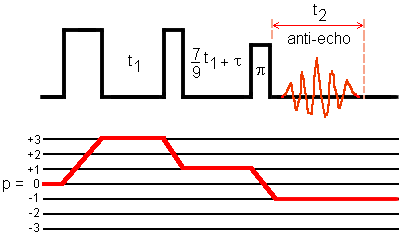
Cogwheel phase cycling in spin-3/2 split-t1
shifted-antiecho 3QMAS pulse program.
Contributor: Y. Millot

Cogwheel phase cycling in spin-3/2 split-t1
shifted-antiecho 3QMAS pulse program.
Contributor: Y. Millot
Below NMR pulse program describes the cogwheel phase cycling in split-t1 approach for (1D and 2D) +3Q-MAS experiment applied to quadrupolar nuclei with 3/2-spin.

Fig. 1: Split-t1 3QMAS NMR pulse sequence and antiecho transfer pathway for a spin I = 3/2 system.
This NMR pulse program is for Bruker Avance spectrometers.
A pure absorption 2D spectrum is obtained without the shearing transformation.
; cogwheelmq3p ; 3Q MAS pulse program for 3/2-spin nuclei ; 3-pulse experiment with full echo acquisition: ; excitation(3Q) - conversion(1Q) - tau - 180° selective - ACQ(-1Q) ; uses split-t1 mode with the whole echo acquisition ; uses cogwheel phase cycling ; cog23(0, 3, 4; 14) === cog23(-14, -11, -10; 0) ; === cog23(9, 12, 13; 0) === cog23(-3, 0, 1; 11) ; for split-t1 set increments as follows: ; set: in10 = in0*7/9, ; or in10 = 0, if no split-t1 is desired ; 180° selective pulse should be determined first using Hahn-echo, ; this may also be used to check that full echo can be obtained ; from sample of interest. If no full echo can be obtained from ; sample, use mq3qzfil instead. ; Then optimise P2 and finally P1, 2 or more iterations for P1 and P2 ; may be needed. ;ns : 23*n ;d1 : recycle delay ;p1 : excitation pulse at pl11 ;p2 : conversion pulse at pl11 ;p4 : 180 degree selective pulse at pl21 ;cnst31 : MAS spin rate ;pl1 : = 120 db ;pl11 : power level for excitation and conversion pulses ;pl21 : power level for 180 degree selective pulse ;d6 : to allow full echo to build up ;l1 : number of rotor cycles for whole echo ;d10 : = 0 ;d11 : = 0 ;d0 : = 1u or longer ;in0 : 1 rotor period for synchronised experiment ;in11 : = 0 ;td1 : number of t1-experiments ;FnMODE : QF ;MC2 : QF "d6=((1s*l1)/cnst31)-(p2/2)-(p4/2)" ; set the delay d6 according to l1 and cnst31 ; values by the spectrometer automatically, ze ; clear memory, new data replace old data, ; switch AD converter to replace mode, ; perform DS before next acquisition, 1 d1 ; recycle delay, 10u pl11:f1 ; 10 microsecond delay, ; set high power in f1 channel, (p1 ph1):f1 ; high-power excitation pulse, d0 ; delay between pulses, t1 increment, (p2 ph2):f1 ; high-power conversion pulse, d10 ; d6 ; delay tau calculated automatically, (p4 pl21 ph3):f1 ; low-power 180° pulse, d11 ; go=1 ph31 ; signal acquisition, ; loop to 1, NS times for averaging, d1 mc #0 to 1 F1QF(id0&id10&id11) ; delay for disk I/O, store signal, ; increase FID number, ; delete memory data, ; do not perform dummy scans ; with next acquisition, ; increment time d0 by in0, ; increment time d10 by in10, ; increment time d11 by in11, exit ; end of the pulse program ph0=0 ph10=(23) 0 1 2 3 4 5 6 7 8 9 10 11 12 13 14 15 16 17 18 19 20 21 22 ; standard phase ph1=ph10*9 ; excitation pulse phase ph2=ph10*12 ; conversion pulse phase ph3=ph10*13 ; 180° pulse phase ph31=0 ; receiver phase
Since the receiver phase ph31 is zero, an offset of FID signal occurs. Set BC drop box to single mode before Fourier transform of the FID signal.
For signal amplitude optimization, use paropt command instead of pop command.